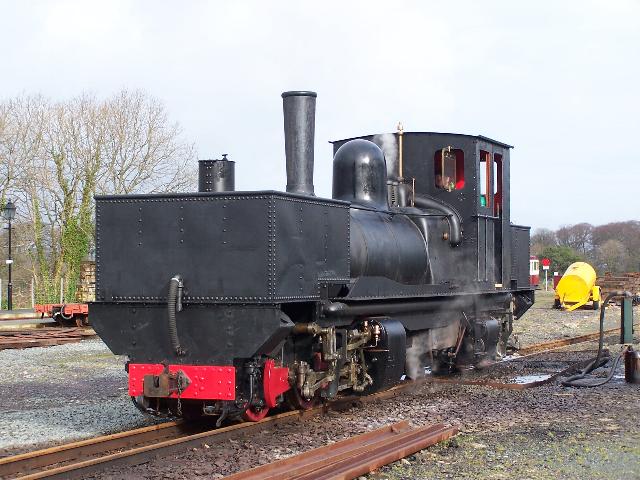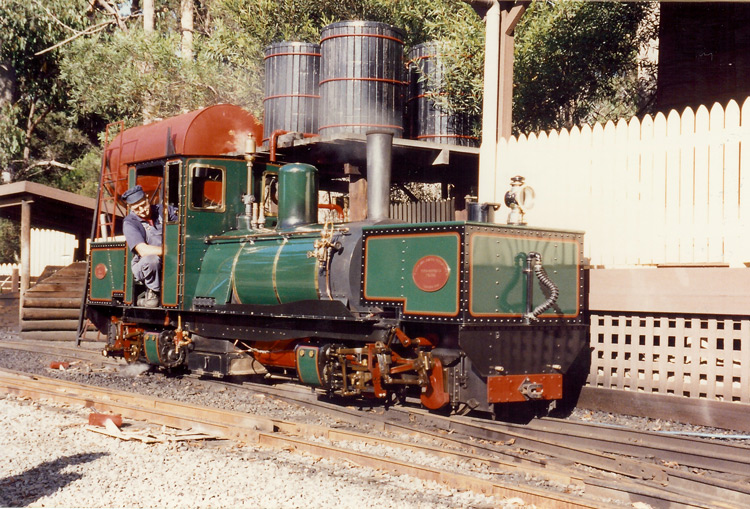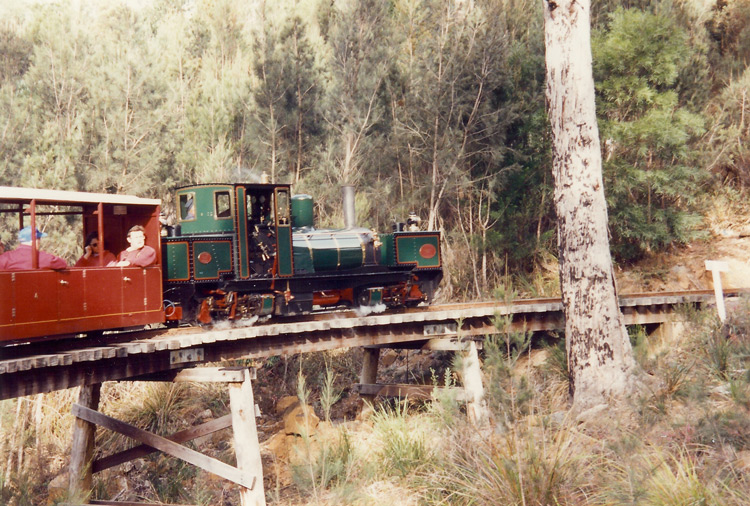
|
K1 The world's first Beyer-Garratt locomotive |

This photo is kindly provided by Ben Fisher and shows newly-restored K1 in steam at Boston Lodge, Ffestiniog Railway, on Sept. 12th 2004.
Original photo by Andy Rutter of the K1 Group (with permission via Ben Fisher).
K1 is one of the most significant preserved Australian steam locomotives, as it and sister K2 were the first in the world built to the Beyer-Garratt articulated locomotive design. Beyer-Garratt locomotives took their name from the patented designs of Herbert William Garratt and were built by (or under subcontract to) Beyer Peacock & Company of Manchester. This significant innovation in locomotive design delivered a large, efficient boiler and deep firebox slung between two bogie power units, providing the tractive effort of two locomotives without the cost of two crews. Articulation made the Beyer-Garratt well suited to tight curves, and coupled with their high tractive effort, the Beyer-Garratt design came to be associated with steep and curvaceous railway routes. c
K1 was built by Beyer Peacock & Co (builder's number 5292 of 1909) a for the Tasmanian Government Railway's North East Dundas Tramway from Zeehan to Williamsford on Tasmania's west coast. K1 and K2 had a 0-4-0 + 0-4-0 wheel configuration, providing good flexibility around the tight curves of the North East Dundas Tramway. K1 and K2 used a compound steam expansion system which was not repeated on subsequent Garratt locomotives, with the rear bogie using high pressure steam and the leading bogie further expanding the steam in larger diameter low-pressure cylinders. a The cylinder positioning on the inside of the bogie was also not repeated on later Garratt locomotives, as this placement led to a hot cab floor. b
Fortunately K1 was saved for preservation as early as 1947 when it was repurchased by Beyer Peacock & Co for display at its Gorton workshops in Manchester. a The preserved K1 contains some components of sister K2, and was apparently rebuilt with some K2 components after lying in storage at Zeehan, Tasmania since about 1939. b
K1 was sold to the Ffestiniog Railway in 1966 after closure of Beyer Peacock & Co. It was subsequently displayed at the National Railway Museum, York during from the 1980's to 1995. b
Since 1995, K1 has been fully overhauled and restored to operation by the "K1 Group" for use on the Welsh Highland Railway, including the construction of a new boiler. Here it complements a fleet of more modern Beyer-Garratt locomotives in the form of ex-South African Railways NGG16-class 2-6-2 + 2-6-2 locomotives. c
A small ceremony took place at the Welsh Highland Railway's Caernarfon station on 5 September 2008 when the UK's Institute of Mechanical Engineers presented the Engineering Heritage award to the K1 Group and a plaque headboard was unveiled on the loco. The plaque reads:
The Beyer Peacock K1 locomotive
Built in 1909 to H. W. Garratt's patent, the first of over 1000 Garratt type
articulated locomotives exported from Manchester to all corners of the world.
They gave reliable service in some of the most remote places on Earth.
A. E. Durrant provides a history of K1 and its context as the pioneer Beyer-Garratt, together with all subsequent Beyer-Garratt locomotives, in his excellent book "Garratt Locomotives of the World".
Today the North East Dundas Tramway provides an excellent bushwalking trail through Tasmanian rainforest national parkland, especially the 10km section from Williamsford to Montezuma Falls. c

This view is dated 28 October 2005 shows K1 hauling a short freight through the curves at Clogwyn-y-gwyn on the Welsh Highland Railway.
The shrill whistle echoed evocatively around the cliffs.
This image is copyright Barrie Hughes and was taken on a Kodak DX6490 digital camera.
Image post processed using iPhoto Plus4 and displayed at 96dpi.

This view is dated 14 February 2005 and shows K1 being readied for the day at Dinas on the Welsh Highland Railway.
This image is copyright Barrie Hughes and was captured on a Kodak DX6490 digital camera.
Image post processed using Iphoto+4 and displayed at 96dpi.

This delightful live steam scale replica of K1 used to operate at the Bush Mill Railway in Tasmania.
Alas the Bush Mill Railway closed when the owners decided to retire and the K1 replica was sold to a UK owner.
The K1 replica is seen here at the Bush Mill railway in a scanned photo view of May 1993.

The Bush Mill Railway included a number of trestle bridges and a Zig-Zag as it wound through a Eucalyptus forest down to a wharf.
This May 1993 view shows the K1 replica working upgrade back towards the terminus station.
References
| a | A. E. Durrant, "Garratt Locomotives of the World" published by Bracken Books, London, 1987 |
| b | L. Oberg, "Locomotives of Australia, Fifth Edition", published by Rosenberg Publishing Pty Ltd, 2010. pp.143-144 |
| c | Webmaster's personal observation or comment. |
Page updated: 18 July 2013